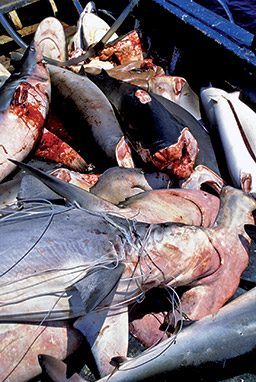UPDATE: This article appeared in the Fall 2010 issue of Alert Diver. On Jan. 4, 2011, the Shark Conservation Act was signed into law by President Barack Obama. The new law requires sharks to be landed whole and prohibits shark fin transfers at sea.
If you ask Hawaii state Senator Clayton Hee, cutting the fins off a great white shark is no different than cutting the horn off a black rhinoceros. It’s a barbaric practice, and the bounty should be treated as contraband. He’s right.

Twenty years ago, Stephen Frink and I saw the horrific results of an illegal longline fishing boat operating in the Galapagos Marine Reserve. The captain of our dive boat, also a reserve officer in the Ecuadorian navy, cunningly donned his uniform to bluff the offending vessel into compliance, allowing us to dive along the line and release those sharks still alive. One small step for shark conservation, and a skirmish won that day. Yet the war continues. Earlier this year, the Hurghada Environmental Protection and Conservation Association (HEPCA) reported several similar incidents in the Red Sea, and dive boat captains actually challenged the fishing boats. Clearly, over the intervening decades shark finning has grown exponentially worse.
The rise in finning is mostly due to an increasing appetite for shark fin soup among affluent Chinese, who consume it as a sign of status and serve it as a sign of respect. The dish has its roots in the ignorant belief that shark fin soup is an aphrodisiac that also retards aging, “strengthens the internal organs” and helps treat cancer. The irony is that the soup is made from chicken or pork stock, with a splash of shark fin cartilage as a garnish. The fin itself provides no taste and little nutritional value.
It’s difficult to say how many sharks are being definned and thrown over the side of the boat to die a gruesome and barbaric death; one widely circulated number is 73 million sharks per year. The University of Hawaii puts it higher, at 89 million. If you look at scalloped hammerheads alone, the International Union for Conservation of Nature (IUCN) reports show declines of 50-90 percent, depending on the region.
How Do We Stop It?
It helps to look at the problem as classic supply and demand. To curb supply, dive boats jumping into the fray, as they are doing in the Red Sea, is a good start. The state of Hawaii made outstanding progress last July with a groundbreaking new law making it illegal to possess, sell or distribute shark fins. Marie Levine, executive director of the Shark Research Institute, says this law will reach far beyond the shores of Hawaii since it plugs loopholes in previous laws that made Hawaii a shark fin distribution center for the Pacific. These are important loopholes to plug; in one example indicative of how serious that problem had become, in 2002 the U.S. Coast Guard intercepted the Honolulu-based fishing vessel King Diamond II in international waters 350 miles from Acapulco, Mexico, transporting 64,000 pounds of dried shark fins, collected at sea mostly from South Korean boats.
The Shark Finning Prohibition Act, implemented in March 2002, makes it illegal for a U.S. fishing vessel anywhere or a foreign ship in U.S. territorial waters to possess the fins of any shark unless the rest of its carcass is also onboard. The Hong Kong-based company that chartered the vessel argued that the King Diamond II was acting as a cargo ship and not a fishing vessel. In 2008, a U.S. Appeals Court ruled in favor of the Hong Kong company, deciding that there was no notice given to the vessel that it would be considered a fishing vessel aiding in shark finning.

Hawaii-based artist Wyland applauded the state legislators who set differences aside to pass the new law. “This law,” he said, “can be the model for other states, and if they act as quickly as Hawaii, we can keep the momentum going.” At the federal level, the Shark Conservation Act of 2009, another major step in prohibiting finning, has already passed the House and is awaiting Senate vote. If the bill hasn’t been voted on by the time you read this, there’s still time to email your senators and tell them to vote yes. (Update: In December 2010, the act was passed in the Senate, and in January 2011, the President signed the Shark Conservation Act into law.)
On the demand side of the problem, WildAid hopes its excellent video featuring Chinese-born NBA star Yao Ming is convincing many would-be shark fin soup patrons to order something else instead. However, as long as Chinese government and business leaders are serving it at official functions, getting everyone else to give up shark fin soup is going to be a tough sell. According to Marcel Bigue, deputy executive director of WildAid, the next step is lobbying China’s most influential cabinet members and CEOs to pledge publicly to quit consuming shark fin soup. More than 40 leaders have already signed up.
Most shark fin soup is served in China, but the problem goes further. Chinese restaurants in the United States are also serving the soup, often on a special menu only for aficionados. Check the restaurant list compiled by the Animal Welfare Institute. If shark fin soup is on the menu in your neighborhood, let the management know how you feel. Only when demand is eliminated will the “supply” be safe.

© Alert Diver — Q4 Fall 2010